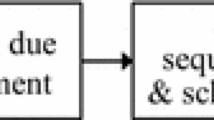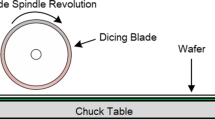Abstract
As semiconductor devices are increasingly employed in consumer electronics and industrial applications, cycle time reduction is critical for semiconductor companies to maintain competitive advantages. Semiconductor manufacturing is capital intensive, in which fab capacity is configured by the interchangeable tools that can be allocated for different steps of reentrant processing. Focusing on realistic needs, this study aims to propose a novel approach that integrates data mining approach to forecast arrival rates and determining the allocation of interchangeable tool sets to reduce the work in process (WIP) bubbles for cycle time reduction. In particular, a hybrid approach of decision tree and back-propagation neural network (BPNN) was developed to forecast the arrival rates of individual tool sets and thus predict the WIP levels of individual tool sets. Therefore, the tool allocation decisions can be generated to minimize the total WIP of interchangeable tool sets given the same throughput level. An empirical study was conducted in a leading semiconductor company in Taiwan for validation. The results have shown practical viability of the proposed approach that can effectively reduce WIP and increase capacity utilization in real settings.








Similar content being viewed by others
References
Amiri, M., Hadadi, B., Amirkhani, A. H., & Izadbakhsh, H. (2008). Supplier selection via principal component analysis: An empirical examination. Journal of Applied Sciences,8(20), 3715–3720.
Berry, M. J., & Linoff, G. (1997). Data mining techniques: For marketing, sales, and customer support. New York: Wiley.
Blum, A. L., & Langley, P. (1997). Selection of relevant features and examples in machine learning. Artificial Intelligence,97(1–2), 245–271.
Breiman, L., Friedman, J. H., Olshen, R. A., & Stone, C. J. (1984). Classification and regression trees. Belmont: Wadsworth.
Byrne, M. D., & Bakir, M. A. (1999). Production planning using a hybrid simulation–analytical approach. International Journal of Production Economics,59(1–3), 305–311.
Carpenter, G. A., Grossberg, S., Markuzon, N., Reynolds, J. H., & Rosen, D. B. (1992). Fuzzy ARTMAP: A neural network architecture for incremental supervised learning of analog multidimensional maps. IEEE Transactions on Neural Networks,3(5), 698–713.
Chambers, M., & Mount-Campbell, C. A. (2002). Process optimization via neural network metamodeling. International Journal of Production Economics,79(2), 93–100.
Chang, P.-C., Chen, S.-H., & Mani, V. (2009). A note on due-date assignment and single machine scheduling with a learning/aging effect. International Journal of Production Economics,117(1), 142–149.
Chang, P.-C., Hsieh, J.-C., & Liu, C.-H. (2006). A case-injected genetic algorithm for single machine scheduling problems with release time. International Journal of Production Economics,103(2), 551–564.
Chen, L.-F., & Chien, C.-F. (2011). Manufacturing intelligence for class prediction and rule generation to support human capital decisions for high-tech industries. Flexible Services and Manufacturing Journal,23(3), 263–289.
Chien, C.-F., & Chen, C.-H. (2007). A novel timetabling algorithm for a furnace process for semiconductor fabrication with constrained waiting and frequency-based setups. OR Spectrum,29(3), 391–419.
Chien, C.-F., Chen, Y.-J., & Hsu, C.-Y. (2015). A novel approach to hedge and compensate the critical dimension variation of the developed-and-etched circuit patterns for yield enhancement in semiconductor manufacturing. Computers and Operations Research,53, 309–318.
Chien, C.-F., Chen, Y.-J., Hsu, C.-Y., & Wang, H. K. (2014a). Overlay error compensation using advanced process control with dynamically adjusted proportional-integral R2R controller. IEEE Transactions on Automation Science and Engineering,11(2), 473–484.
Chien, C.-F., Chen, Y.-J., & Peng, J.-T. (2010). Manufacturing intelligence for semiconductor demand forecast based on technology diffusion and product life cycle. International Journal of Production Economics,128(2), 496–509.
Chien, C.-F., & Chuang, S.-C. (2014). A framework for root cause detection of sub-batch processing system for semiconductor manufacturing big data analytics. IEEE Transactions on Semiconductor Manufacturing,27(4), 475–488.
Chien, C.-F., Dou, R.-L., & Fu, W.-H. (2018). Strategic capacity planning for smart production: Decision modeling under demand uncertainty. Applied Soft Computing,68, 900–909.
Chien, C.-F., Hsiao, A., & Wang, I. (2004). Constructing semiconductor manufacturing performance indexes and applying data mining for manufacturing data analysis. Journal of the Chinese Institute of Industrial Engineers,21(4), 313–327.
Chien, C.-F., & Hsu, C.-Y. (2006). A novel method for determining machine subgroups and backups with an empirical study for semiconductor manufacturing. Journal of Intelligent Manufacturing,17(4), 429–439.
Chien, C.-F., Hsu, C.-Y., & Chen, P.-N. (2013). Semiconductor fault detection and classification for yield enhancement and manufacturing intelligence. Flexible Services and Manufacturing Journal,25(3), 367–388.
Chien, C.-F., Hsu, C.-Y., & Hsiao, C.-W. (2012a). Manufacturing intelligence to forecast and reduce semiconductor cycle time. Journal of Intelligent Manufacturing,23(6), 2281–2294.
Chien, C.-F., Liu, C.-W., & Chuang, S.-C. (2017). Analysing semiconductor manufacturing big data for root cause detection of excursion for yield enhancement. International Journal of Production Research,55(17), 5095–5107.
Chien, C.-F., Wu, C., & Chiang, Y. (2012b). Coordinated capacity migration and expansion planning for semiconductor manufacturing under demand uncertainties. International Journal of Production Economics, 135(2), 860–869.
Chien, C.-F., & Wu, J.-Z. (2003). Analyzing repair decisions in the site imbalance problem of semiconductor test machines. IEEE Transactions on Semiconductor Manufacturing, 16(4), 704–711.
Chien, C.-F., Zheng, J.-N., & Lin, Y.-J. (2014b). Determining the operator-machine assignment for machine interference problem and an empirical study in semiconductor test facility. Journal of Intelligent Manufacturing,25(5), 899–911.
Chou, C.-W., Chien, C.-F., & Gen, M. (2014). A multiobjective hybrid genetic algorithm for TFT-LCD module assembly scheduling. IEEE Transactions on Automation Science and Engineering, 11(3), 692–705.
Connors, D. P., Feigin, G. E., & Yao, D. D. (1996). A queueing network model for semiconductor manufacturing. IEEE Transactions on Semiconductor Manufacturing,9(3), 412–427.
Dai, H., & MacBeth, C. (1997). Effects of learning parameters on learning procedure and performance of a BPNN. Neural Networks,10(8), 1505–1521.
Eberhart, R. C., & Dobbins, R. W. (1990). Neural network PC tools. London: Academic Press.
Fu, Y. (1997). Data mining: Tasks, techniques and applications. IEEE Potentials,16(4), 18–20.
Guyon, I., & Elisseeff, A. (2003). An introduction to variable and feature selection. Journal of Machine Learning Research,3, 1157–1182.
Han, J., Pei, J., & Kamber, M. (2011). Data mining: Concepts and techniques. Amsterdam: Elsevier.
Hazen, B. T., Skipper, J. B., Boone, C. A., & Hill, R. R. (2016). Back in business: Operations research in support of big data analytics for operations and supply chain management. Annals of Operations Research. https://doi.org/10.1007/s10479-016-2226-0.
Hopp, W. J., Spearman, M. L., Chayet, S., Donohue, K. L., & Gel, E. S. (2002). Using an optimized queueing network model to support wafer fab design. IIE Transactions,34(2), 119–130.
Hsieh, L. Y., Chang, K. H., & Chien, C. F. (2014). Efficient development of cycle time response surfaces using progressive simulation metamodeling. International Journal of Production Research,52(10), 3097–3109.
Hsu, C.-Y., Lin, S.-C., & Chien, C.-F. (2015). A back-propagation neural network with a distributed lag model for semiconductor vendor-managed inventory. Journal of Industrial and Production Engineering,32(3), 149–161.
Hsu, S.-C., & Chien, C.-F. (2007). Hybrid data mining approach for pattern extraction from wafer bin map to improve yield in semiconductor manufacturing. International Journal of Production Economics,107(1), 88–103.
Iwata, Y., Taji, K., & Tamura, H. (2003). Multi-objective capacity planning for agile semiconductor manufacturing. Production Planning and Control,14(3), 244–254.
Jamrus, T., Chien, C.-F., Gen, M., & Sethanan, K. (2018). Hybrid particle swarm optimization combined with genetic operators for flexible job-shop scheduling under uncertain processing time for semiconductor manufacturing. IEEE Transactions on Semiconductor Manufacturing,31(1), 32–41.
Khakifirooz, M., Chien, C.-F., & Chen, Y.-J. (2018). Bayesian inference for mining semiconductor manufacturing big data for yield enhancement and smart production to empower Industry 4.0. Applied Soft Computing,68, 990–999.
Khaw, J. F., Lim, B. S., & Lim, L. E. (1995). Optimal design of neural networks using the Taguchi method. Neurocomputing,7(3), 225–245.
Kim, B., & Kim, S. (2001). Extended model for a hybrid production planning approach. International Journal of Production Economics,73(2), 165–173.
Kuo, C.-J., Chien, C.-F., & Chen, J.-D. (2011). Manufacturing intelligence to exploit the value of production and tool data to reduce cycle time. IEEE Transactions on Automation Science and Engineering,8(1), 103–111.
Li, L., Chi, T., Hao, T., & Yu, T. (2018). Customer demand analysis of the electronic commerce supply chain using Big Data. Annals of Operations Research,268(1–2), 113–128.
Li, N., Zhang, M. T., Deng, S., Lee, Z.-H., Zhang, L., & Zheng, L. (2007). Single-station performance evaluation and improvement in semiconductor manufacturing: A graphical approach. International Journal of Production Economics,107(2), 397–403.
Lin, H.-T., & Liao, C.-J. (2003). A case study in a two-stage hybrid flow shop with setup time and dedicated machines. International Journal of Production Economics,86(2), 133–143.
Little, J. (1961). A proof of the theorem L = λW. Operations Research,9(3), 383–387.
Lolas, S., & Olatunbosun, O. A. (2008). Prediction of vehicle reliability performance using artificial neural networks. Expert Systems with Applications,34(4), 2360–2369.
Marenn, A. J., Jones, D., & Franklin, S. (1990). Configuring and optimizing the back-propagation network: Handbook of neural computing applications. San Diego: Academic Press.
Moore, G. E. (1965). Cramming more components onto integrated circuits. Electronics,38(8), 114–117.
Nazzal, D., Mollaghasemi, M., & Anderson, D. (2006). A simulation-based evaluation of the cost of cycle time reduction in Agere systems wafer fabrication facility—A case study. International Journal of Production Economics,100(2), 300–313.
Nouri, N., & Ladhari, T. (2018). Evolutionary multiobjective optimization for the multi-machine flow shop scheduling problem under blocking. Annals of Operations Research,267(1–2), 413–430.
Qiu, R. G. (2005). Virtual production line based WIP control for semiconductor manufacturing systems. International Journal of Production Economics,95(2), 165–178.
Roiger, R. J., & Geatz, M. W. (2003). Data mining: A tutorial-based primer. Boston, MA: Addison-Wesley.
Scholl, W., & Domaschke, J. (2000). Implementation of modeling and simulation in semiconductor wafer fabrication with time constraints between wet etch and furnace operations. IEEE Transactions on Semiconductor Manufacturing,13(3), 273–277.
Setiono, R., & Liu, H. (1997). Neural-network feature selector. IEEE Transactions on Neural Networks,8(3), 654–662.
Shanthikumar, J. G., Ding, S., & Zhang, M. T. (2007). Queueing theory for semiconductor manufacturing systems: A survey and open problems. IEEE Transactions on Automation Science and Engineering,4(4), 513–522.
Shih, W., Chien, C.-F., Shih, C., & Chang, J. (2009). The TSMC way: Meeting customer needs at Taiwan Semiconductor Manufacturing Co. Boston, MA: Harvard Business School Case Study (9-610-003).
Sobeyko, O., & Mönch, L. (2015). Grouping genetic algorithms for solving single machine multiple orders per job scheduling problems. Annals of Operations Research,235(1), 709–739.
Uzsoy, R., Lee, C. Y., & Martin-Vega, L. A. (1992). A review of production planning and scheduling models in the semiconductor industry part I: System characteristics, performance evaluation and production planning. IIE Transactions,24(4), 47–60.
Wang, H.-K., Chien, C.-F., & Chou, C.-W. (2017). An empirical study of bio manufacturing for the scheduling of hepatitis in vitro diagnostic device with constrained process time window. Computers and Industrial Engineering,114, 31–44.
Wang, H.-K., Chien, C.-F., & Gen, M. (2015). An algorithm of multi-subpopulation parameters with hybrid estimation of distribution for semiconductor scheduling with constrained waiting time. IEEE Transactions on Semiconductor Manufacturing,28(3), 353–366.
Wang, K.-J., Chen, J.-C., & Lin, Y.-S. (2005). A hybrid knowledge discovery model using decision tree and neural network for selecting dispatching rules of a semiconductor final testing factory. Production Planning and Control,16(7), 665–680.
Wu, J.-Z., Hao, X.-C., Chien, C.-F., & Gen, M. (2012). A novel bi-vector encoding genetic algorithm for the simultaneous multiple resources scheduling problem. Journal of Intelligent Manufacturing, 23(6), 2255–2270.
Wu, M.-C., Jiang, J.-H., & Chang, W.-J. (2008). Scheduling a hybrid MTO/MTS semiconductor fab with machine-dedication features. International Journal of Production Economics,112(1), 416–426.
Yoon, H., Yang, K., & Shahabi, C. (2005). Feature subset selection and feature ranking for multivariate time series. IEEE Transactions on Knowledge and Data Engineering,17(9), 1186–1198.
Yu, C.-M., Chien, C.-F., & Kuo, C.-J. (2017). Exploit the value of production data to discover opportunities for saving power consumption of production tools. IEEE Transactions on Semiconductor Manufacturing,30(4), 345–350.
Yu, C.-Y., & Huang, H.-P. (2002). On-line learning delivery decision support system for highly product mixed semiconductor foundry. IEEE Transactions on Semiconductor Manufacturing,15(2), 274–278.
Yu, H.-C., Lin, K.-Y., & Chien, C.-F. (2014). Hierarchical indices to detect equipment condition changes with high dimensional data for semiconductor manufacturing. Journal of Intelligent Manufacturing, 25(5), 933–943.
Author information
Authors and Affiliations
Corresponding author
Rights and permissions
About this article
Cite this article
Chien, CF., Kuo, CJ. & Yu, CM. Tool allocation to smooth work-in-process for cycle time reduction and an empirical study. Ann Oper Res 290, 1009–1033 (2020). https://doi.org/10.1007/s10479-018-3034-5
Published:
Issue Date:
DOI: https://doi.org/10.1007/s10479-018-3034-5




